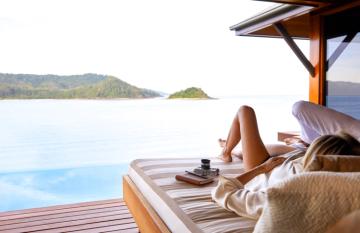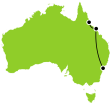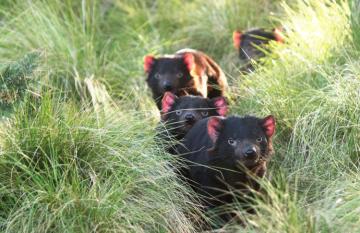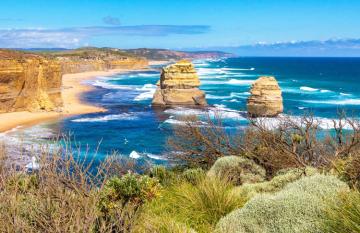
Seeing cuddly koalas is high on every visitor's bucket list of things to do in Australia. From national parks to koala sanctuaries and zoos, there is no shortage of places to encounter a koala. Here’s all you need to know about these fascinating animals and the best places to spot them on your next trip to Australia.
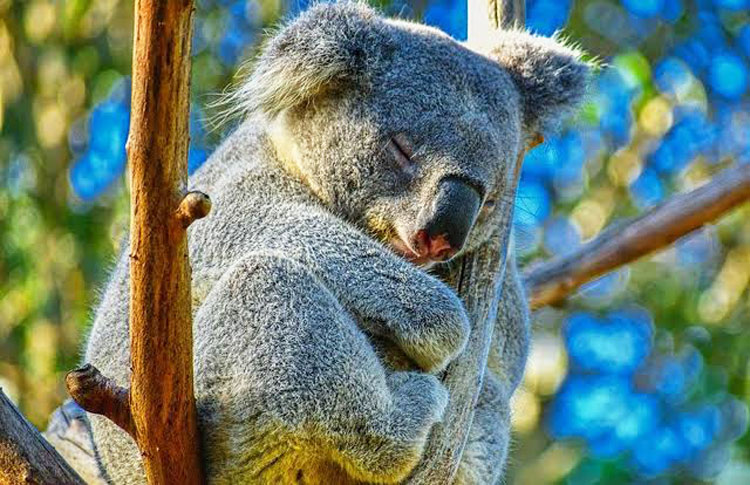
Learn More About Koalas
Origins of the Koala
Koalas have inhabited the Australian continent for 25 million years. Local Aboriginal peoples were aware of the existence of koalas from the time of their arrival to the continent some 60,000 years ago. They used koalas for food, carved their images in rocks, and featured them in their Dreamtime Stories. One of the myths even tells how koalas helped row the boat that brought the Indigenous Thurrawal people to Australia.
The word koala has its origins in Aboriginal languages. There are no less than a dozen native koala names, including kaola, koalo, colah, koolewong, and koobor. All these names have the same meaning: “no water”.
Although they are often referred to as koala bears—even their scientific name phascolarctos cinereus means “ash-grey pouched bear”—these cuddly animals are not related to bears at all. Instead, their closest relatives are short-legged, muscular native Australian wombats.
Like wombats, koalas are marsupials: their females grow young ones, called joeys, in a pouch. A newborn baby koala is blind, hairless, and hardly any bigger than a jellybean. It first leaves its mother’s pouch at about 6 months, when it starts clinging to her back or stomach, occasionally sticking its head into the pouch to feed. Koalas become fully independent at 12 months and live for around 12 years in the wild or 15 years in captivity.
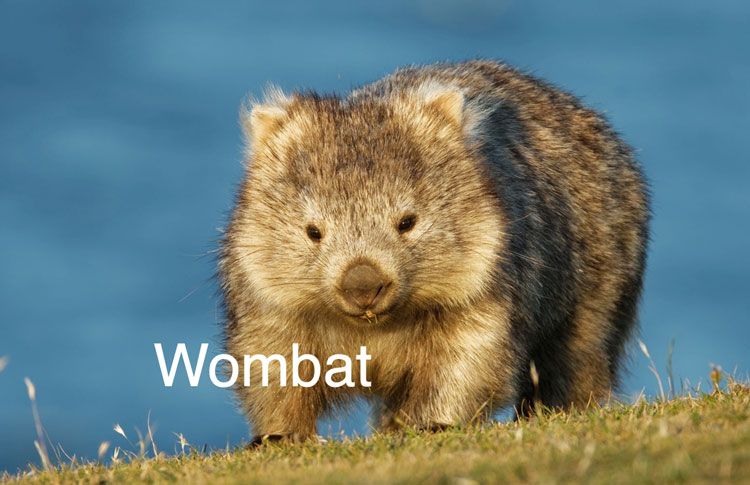
Koala Characteristics and Lifestyle
Koalas have poor vision and their black buttonlike eyes can’t see distant objects. At the same time, they are equipped with exceptional senses of hearing and smell. Their characteristic spoon-shaped noses allow them to differentiate between fresh and rotten eucalyptus leaves and sense predators. Koalas’ large ears provide the animals with an excellent sense of hearing, indispensable for communicating with other koalas.
Koala hands are equipped with 3 fingers and 2 thumbs, along with long claws that come in handy for climbing into their mother’s pouch and gripping tree branches. Koalas are the only animal species, besides chimpanzees and gorillas, to have individual human-like fingerprints. They are so similar to those of humans, in fact, that they could easily be confused.
The fluffy fur, which is coarser than it looks, provides insulation and protects koalas against the cold weather and rain. In Victoria and South Australia, koalas have thick brown fur that helps them survive the colder climates of the region. The fur of Queensland koalas, on the contrary, is grey and a bit thinner. Queensland koalas are also much smaller than the others.
Koalas spend around 20 hours every day asleep in trees. A great amount of energy is needed to digest eucalyptus leaves that are low in nutrients and high in fibre. They are left with very little energy to do anything else but sleep. Their sedentary lifestyle is also due to the koala’s exceptionally small brain—it is the smallest of all mammal brains and weighs a mere 17 g (0,6 oz)—limiting the ability to lead a more complex lifestyle.
Koalas are solitary animals that rarely communicate or interact with each other. Surprisingly, these cute marsupials are equipped with an extremely loud and unsettling voice. The sound they make is called a “bellow” and resembles a snore followed by a belch. Koalas are among the loudest mammals you’ll ever meet in the Australian bush: their voices can be heard miles away.

Koalas and Eucalyptus
Koalas are folivores which means that their diet consists exclusively of leaves. They can consume as much as 500 g (17 oz) of fragrant eucalyptus leaves every day. Australia has more than 900 native eucalyptus species, but koalas are “fussy eaters”: they feed exclusively on 30-40 types of eucalyptus. They also prefer leaves at the top of the trees that contain more nutrients. Since over 60% of eucalyptus leaves is water, koalas don’t drink much, although they can become dehydrated in very high temperatures.
Koalas’ digestive system is equipped with micro-organisms that detoxify eucalyptus leaves, highly poisonous to all other animals. Before eating, koalas carefully analyse the contents of the leaves by touching and smelling them. They need to make sure that the leaves don’t exceed certain levels of toxic eucalyptol, the main component in eucalyptus oil.
Koalas eat several times per day, mostly before sunrise, occasionally in the afternoon, and then before and after the sunset. That’s why you will rarely see a wild koala feeding on eucalyptus leaves during the day.
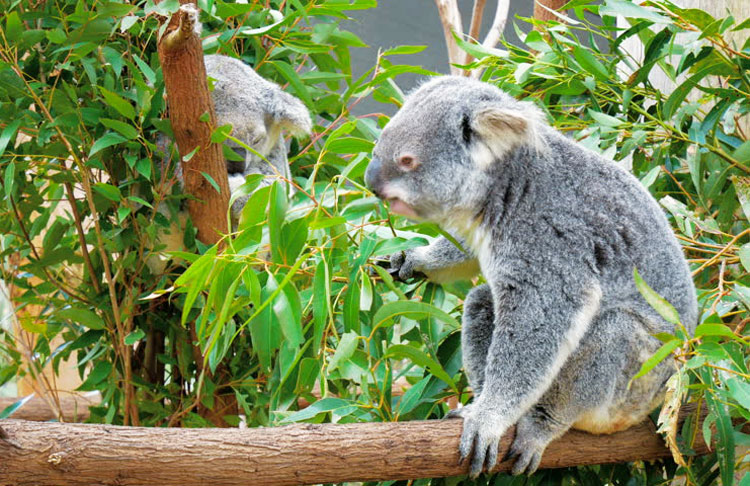
Are Koalas Endangered?
Millions of koalas used to inhabit the Australian continent, except for Tasmania that has no fossil evidence of the marsupials. European settlers saw koalas as the perfect source of fur for trade. During the six-month open koala hunting season in Queensland in 1919, close to a million koalas were killed. Public outrage forced the government to declare koalas a protected species in the late 1930s. Australian Koala Foundation estimates that fewer than 80,000 koalas are left in the wild.
Today, the major threat to koalas is habitat loss. Much of the koala's habitat overlaps with areas where extensive clearing is occurring due to rapid urban development.
Other serious threats to koalas are injuries from cars and dog attacks, followed by the highly infectious, lethal disease chlamydia. Surveys show that almost the entire wild population of koalas has been infected with chlamydia. The disease is made worse by the stress resulting from habitat loss, heat waves, and malnutrition.
Each year, hundreds of koalas are victims of bushfires. Since their immune system is extremely weak, koalas facing burns have low chances of survival. Recent headlines suggest that bushfires have now destroyed up to 80% of the koala's habitat, making the species close to being considered "functionally extinct". While not extinct just yet, they will need human care in order for the species to survive.
The Australian bushfires which have ravaged the country since September 2019 and through the summer of 2020 are had a devastating impact on wildlife populations. Ecologists from the University of Sydney estimate 8000 koalas are believed to have died in these fires - nearly one third of the entire koala population in New South Wales (NSW). Koala numbers are believed to have declined across a number of states, but the figures remain unclear.
Like all other native Australian animals, koalas are listed as Australian endangered species and classified as vulnerable on the IUCN Red List of Threatened Species. Eating koalas or keeping them as pets anywhere in the world is illegal.
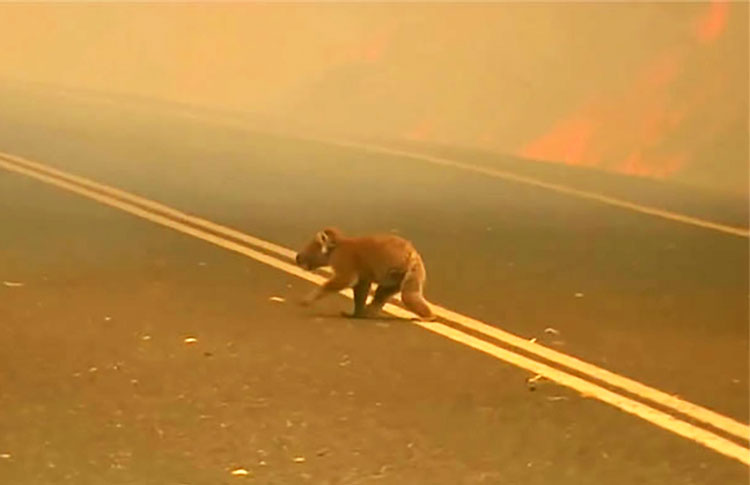
Can You Cuddle a Koala?
Holding and cuddling a koala in the wild is not permitted in Australia. Visitors should never approach or touch a wild koala in their natural habitat. Koalas may be extremely cute, but they are still capable of biting and scratching (remember they have very sharp claws).
Holding a koala is not permitted anywhere in Victoria, New South Wales, Tasmania, and the Northern Territory. In Queensland, Western Australia, and South Australia cuddling a koala in zoos and wildlife sanctuaries is permitted, but still not all places allow it. Exposure to people and noise can be very distressing to these adorable animals. Visitors are only allowed to hold koalas that are comfortable around humans for a limited period of time, to make sure they remain healthy and happy.
Cuddling a koala—things to keep in mind:
Check the website of the zoo or sanctuary you are planning to visit for conditions and hours when you can meet the koalas.
Holding a koala is a popular experience, so it is always a good idea to book in advance.
Encounters with koalas in sanctuaries and zoos are supervised. You will have enough time to stroke a koala and take a few selfies, but the sessions are often limited to 5-10 minutes.
You are not always allowed to take own photos with koalas. Most places, however, offer professional photographs for a fee. Remember to check the conditions and prices before visiting.
There is a lower age limit for cuddling a koala. Young children are often not allowed in the enclosures, but age and height limits vary. Older children must be supervised by their parents.
Keep in mind that koalas can be quite heavy, weighing up to 12 kg (26 lb).
Cuddling a koala usually comes at an additional cost, which is not included in the zoo/ sanctuary entrance fee. Prices start at AU$20 and can be as high as AU$49 per person in Australia Zoo.
Getting close to koalas is a great opportunity to meet the caretakers of these fascinating creatures. Don’t hesitate to ask anything you wish to know about koalas. Use this opportunity to get the answers from experts first-hand.

Where to See Koalas in the Wild
Nothing can match seeing koalas in the wild, munching on eucalyptus leaves, sleeping in tree forks, or jumping from branch to branch (koalas are great jumpers). But finding koalas in their natural habitat is not always as simple as it looks. These are rather shy and elusive animals, and their colour can easily be mistaken for that of the eucalyptus.
Remember that koalas are nocturnal animals. It is more difficult to spot them during the day as they move less, particularly in the summer. The best time to look for koalas is early mornings and late afternoons when they are more active.
Tips for spotting koalas in the wild:
Koalas can be found in open forests and woodlands in the coastal regions of Queensland, Victoria, New South Wales, and South Australia. Northern Territory and West Australia have no remaining koala population, and there are no koalas in Tasmania.
If you see fresh eucalyptus leaves or koala scats on the ground, have a look directly above: a koala may just be hiding up in the eucalyptus tree.
To increase your chances of seeing koalas in the wild, you should consider remaining in the same area for a few days. National parks offer various accommodation options.
Don’t hesitate to ask Visitor Information Centres about the best places to spot wild koalas in the region. They will be happy to point you in the right direction.
If you come across a sick or injured koala, you should contact the local wildlife organisation. They will help you get in touch with registered koala rescue and care teams.
Keep in mind that injured koalas bite and scratch.
Read the Wildlife Rescue emergency advice before starting the trip.
Be sure to learn some basic facts about koala behaviour. For example, they raise their ears upwards as a sign of an alert or agitation, while ears pulled backwards are an indicator of distress.
Check the national park’s website before you visit for the up-to-date information on temporary closures. Access to parks may be restricted due to weather conditions and bushfires.
While entrance to national parks is often free, transportation to the islands by ferry can be pricey, especially if you are bringing a car.
Make sure to drive very carefully and avoid driving at dawn, dusk, and night time. That is when koalas and other native animals wander across the roads, and hundreds of koalas are killed by cars on Australian roads every year. Look for “Koalas Cross Here” road signs and watch for koala eyeshine in the dark.
Victoria: Where to spot wild Koalas
Great Ocean Road
The Great Ocean Road, one of the world’s most scenic drives, is the perfect place to see koalas in the wild. Here are some popular places to stop and look for these amazing animals:
Kennett River
With its significant koala population, Kennett River is often considered being the koala capital of Australia. This is one of the best settings to get a glimpse of wild koalas near Melbourne. Take a walk or drive along the Grey River Road and you’ll easily come across some sleepy furballs in eucalyptus trees. If you visit Kenneth River in the spring, you may even spot a cute young baby koala or two.
Phillip Island
The eucalyptus woodland of Phillip Island offers fantastic opportunities to come close to koalas in their natural habitat. Head to the Koala Reserve’s tree-top boardwalk to get a closer view and join a Koala Eco-Explorer Tour where rangers share in-depth information about koalas on the island.
French Island National Park
French Island National Park is home to a healthy population of wild koalas, used to repopulate other areas since they are largely free from the devastating chlamydia. Keep an eye on the tree forks along the Pinnacles Track, and you might just spot a koala resting there. Fairhaven campground offers an unforgettable experience of sleeping under the stars with the koalas. Camping is free of charge, but you must book a pitch in advance.
Great Otway National Park
Koalas abound in Cape Otway National Park. You can easily spot them along Lighthouse Road, but make sure to park in a safe spot as the road can be very busy with traffic. Combine your quest for koalas with a visit to Cape Otway Lighthouse, the oldest surviving lighthouse on mainland Australia. If you are planning to spend more time in the area, Cape Otway Bimbi Park offers the option of camping underneath the koalas.
Raymond Island
Koalas were introduced to Raymond Island in 1953 as part of a conservation initiative, and today this is one of the prime spots to see koalas in Australia. There are approximately 200 of these cute tree-hugging creatures on the island. You can find them in the trees along the clearly marked Koala Trail, but it is not unusual to see them crossing the street or perched on pavements around the island.
Warrandyte State Park
Warrandyte State Park is the closest national park to Melbourne, only half an hour's drive from the CBD. You’ll have a good chance of seeing a koala in the trees at Pound Bend Reserve, a popular picnic ground with several easy walks and trails along the Yarra River.
Inspiration: driving holidays in Victoria
Queensland: Where to spot wild Koalas
Magnetic Island National Park
Located within the World Heritage-listed Great Barrier Reef, Magnetic Island is the home of one of Australia's largest wild koala populations with more than 1,000 koalas. And the best part is, they are not too difficult to spot since eucalyptus trees here are quite low. Forts Walk, the island’s popular track with a stunning panoramic view of the area, is perfect for encountering these enigmatic creatures.
Brisbane Koala Bushlands
Brisbane Koala Bushlands is a network of natural areas set aside to protect the koala habitat. The bushlands are part of the Koala Coast Network, one of the most important areas inhabited by koalas. Follow the Stockyard Creek walking track and stop at a viewing deck from which you are guaranteed to spot some snoozy koalas.
Brisbane Ranges National Park
Brisbane Ranges National Park koalas are descendants from French Island and Phillip Island ones, brought here in the 1950s and 1970s. Today, the park has the highest density of koalas in Victoria. There are good chances to see them in the northern part of the park, near Reids Road. Besides koalas, look for kangaroos, wallabies, echidnas, and possums. Don't miss the stunning wild flora—Brisbane Ranges is known as the richest wildflower habitat in the state.
North Stradbroke Island
North Stradbroke Island, with its vast range of nature walks, is one of the world’s largest sand islands and home to the only naturally occurring island populations of koalas. North Stradbroke offers numerous opportunities to spot koalas in the wild.
Self-drive holiday options in Queensland
New South Wales: Where to spot wild Koalas
Tilligerry Habitat
Tilligerry Habitat is a community-based ecotourism park close to Sydney, with plenty of easy walking tracks through the scenic swamp mahogany forest. Tilligerry Information Centre regularly sends out scouts to find koalas and map their location for visitors.
Browse our New South Wales self-drive packages
South Australia: Where to spot wild Koalas
Kangaroo Island
Kangaroo Island is one of the world's last unspoiled island wilderness inhabited by koalas, but also kangaroos, wallabies, echidnas, and many other native Australian animals. Eighteen koalas were introduced to the island in the 1920s to prevent the diminishing population from going extinct.
Until the recent 2019-2020 bushfires, Kangaroo Island had more than 50,000 koalas, but it is estimated that fewer than half remain.
South Australia self-drive itineraries
Western Australia: Where to spot wild Koalas
Yanchep National Park
Yanchep National Park near Perth has a small koala population. The raised Koala Park boardwalk gives a close view of the animals in their natural environment, and visitors can learn more about these fascinating creatures during free daily koala talks.
Trip-planning inspiration: stunning Aussie self-drive itineraries for nature lovers
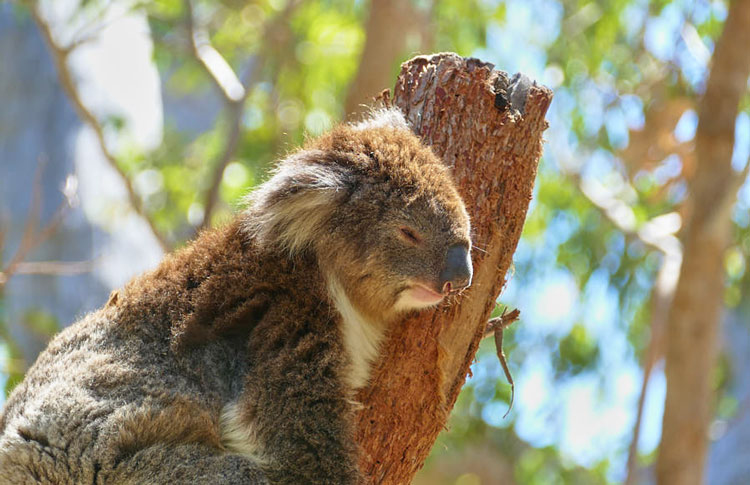
Koala Sanctuaries and Zoos
Koala sanctuaries and zoos are often conveniently located near major cities. This might be the best option if your time in Australia is limited or if you wish to see koalas in a semi-wild setting and get the opportunity to hold and cuddle them.
Victoria
Healesville Sanctuary
Located in the picturesque Yarra Valley an hour drive from Melbourne, Healesville Sanctuary is home to free-roaming koalas and hundreds of other species of Australian animals. Take a walk through the treetop platforms to get a glimpse of koalas in eucalyptus trees. You can also learn about the conservation efforts of the sanctuary and listen to keepers and vets talk about their work with the animals.
Maru Koala and Animal Park
Family run, award-winning Maru Koala and Animal Park features koalas and several other native animals. Join hourly guided tours inside the koala area, where you are also welcome to pet and hand-feed these fascinating marsupials.
Moonlit Koala Sanctuary
Melbourne’s Moonlit Sanctuary is a wildlife conservation park housing more than 70 native Australian species. You can cuddle one of their friendly koalas and talk with their knowledgeable animal keepers.
Melbourne Zoo
Melbourne Zoo recently celebrated the arrival of its newest koala, the first to be born at the zoo in almost a decade. The zoo offers a private experience that includes taking a professional photo with a koala in its enclosure and chatting with its caretaker.
New South Wales
Koala Park Sanctuary
Koala Park Sanctuary on the outskirts of Sydney is home to Australia’s first koala hospital. It opened in 1930 to protect the koalas that were targeted for the fur trade. The sanctuary hosts various koala presentations and is a great place to learn more about one of Australia’s most cuddly creatures.
Wildlife Sydney Zoo
Located on the water’s edge of Darling Harbour, Wildlife Sydney Zoo offers a unique possibility to have breakfast inside a koala enclosure, have professional photos taken, and hear experts talk about their work with koalas.
Featherdale Wildlife Park
Featherdale Wildlife Park, only 45 minutes’ drive from the heart of Sydney, has the world's largest collection of Australian native animals, including koalas, in an authentic bush environment. For a memorable Aussie experience, you can hold a koala, take a selfie, and talk to their staff who are really caring and knowledgeable about the animals.
Queensland
Lone Pine Koala Sanctuary
Lone Pine is the first and largest koala sanctuary in the world. It was established in 1927 to care for sick, injured, and orphaned koalas at a time when they were being massively hunted for the fur trade. Today, the sanctuary provides a home and protection to around 130 koalas, many of whom were born on site.
In 2018, Lone Pine opened the Brisbane Koala Science Institute, a koala science and research facility with a koala biobank, a frozen tissue repository. The institute offers a koala skywalk and interactive displays in addition to the viewing of the research laboratory and wildlife hospital.
Currumbin Wildlife Sanctuary
Currumbin Wildlife Sanctuary on the Gold Coast is worth visiting for a unique encounter with more than 50 friendly koalas. Be sure to visit the Currumbin Wildlife Hospital, where hundreds of sick and injured koalas are treated every year before they are released into the wild. From the hospital viewing deck, you can watch animals being tended to by the sanctuary’s vet team.
Australia Zoo
Australia Zoo, with 1,200 animals and counting, is Australia’s most famous zoo due to the efforts of the Irwin family. Koala encounters allow visitors to have a heartwarming cuddle with one of their koalas and chat with experienced keepers about what is involved in caring for some of the most popular zoo residents.
Kuranda Koala Gardens
Located in the rainforest near Cairns, Kuranda gives visitors the opportunity to see plenty of native animals, but the koalas are the central focus of the gardens. Take the opportunity to cuddle a koala and get a souvenir photo. Kuranda prides itself for its adherence to a strict Government Code of Practice, ensuring the good health and wellbeing of their koalas.
South Australia
Cleland Wildlife Park
Cleland Wildlife Park in the vicinity of Adelaide has only a few enclosures, and the majority of koalas live in their natural habitat. The animals are fully adapted to the park environment and used to visitors. That means that you can hold and feed them while you chat with a koala keeper and have your photo taken.
Hanson Bay Wildlife Sanctuary
Hanson Bay Wildlife Sanctuary on Kangaroo Island is a perfect place to get a glimpse of koalas. There are no cages, fences, or barriers, and koalas are free to come and go as they please. The famous Koala Walk is the most popular spot to look for the cuddly creatures—you can see up to 20 koalas at one time relaxing on the eucalyptus trees. Each morning volunteers take a walk around the grounds and place flags in front of the trees in which they spot koalas so that visitors can easily find them too.
Gorge Wildlife Park
Gorge Wildlife Park is among the largest privately owned collections of local and exotic animals in the country. You can get up close and personal with wombats, kangaroos, dingoes, echidnas, Tasmanian devils, and of course, koalas. Gorge Park is one of the very few wildlife attractions in South Australia where koala holding is permitted. This family-operated park is also the only place where you can hold and take a photo with a koala at no extra charge to the admission fee.
Western Australia
Cohunu Koala Park
Head to Cohunu Koala Park if you wish to hold a koala for a souvenir photo—this is the only place in Western Australia where cuddling koalas is allowed. The Cohunu colony was established in 1982 with the arrival of 4 koalas from South Australia. The park now boasts more than 25 koalas and increases by approximately 4 joeys each year.
Tasmania
Bonorong Wildlife Sanctuary
Bonorong is an animal sanctuary dedicated to injured and orphaned wildlife and Tasmania's most popular wildlife park. A free tour includes the opportunity to feel the koala’s fur if they’re up for it (holding a koala is not permitted in Tasmania). The animal keepers will be happy to share with you their passion for Tasmanian wildlife.
Start Planning Your Trip
There are plenty of places throughout Australia where you can see koalas both in the wild and in captivity. However, careful planning is recommended if you wish to make the most out of your experience. First Light Travel self-drive itineraries feature many of the locations where you can see koalas.
There are plenty of options to choose from. Or, feel free to jump on the phone (or chat online) with FLT’s friendly staff and create your own customised trip.
Recent Posts
Blog Categories
Blog archives
- March 2025 (1)
- November 2024 (1)
- October 2024 (1)
- September 2024 (8)
- June 2024 (4)
- May 2024 (2)
- April 2024 (2)
- March 2024 (13)
- February 2024 (3)
- January 2024 (5)
- December 2023 (6)
- November 2023 (4)
- October 2023 (11)
- September 2023 (2)
- August 2023 (6)
- July 2023 (2)
- June 2023 (17)
- May 2023 (3)
- April 2023 (5)
- March 2023 (8)
- February 2023 (9)
- January 2023 (12)
- December 2022 (9)
- November 2022 (12)
- October 2022 (12)
- September 2022 (12)
- August 2022 (6)
- July 2022 (9)
- June 2022 (7)
- May 2022 (3)
- April 2022 (4)
- March 2022 (6)
- February 2022 (1)
- January 2022 (4)
- December 2021 (2)
- November 2021 (3)
- October 2021 (1)
- September 2021 (4)
- August 2021 (10)
- July 2021 (13)
- June 2021 (6)
- April 2021 (2)
- March 2021 (2)
- February 2021 (1)
- January 2021 (1)
- December 2020 (2)
- November 2020 (3)
- October 2020 (2)
- September 2020 (1)
- August 2020 (1)
- July 2020 (1)
- June 2020 (1)
- May 2020 (1)
- March 2020 (1)
- February 2020 (2)
- January 2020 (4)
- December 2019 (2)
- November 2019 (1)
- October 2019 (1)
- September 2019 (5)
- August 2019 (1)
- July 2019 (5)
- June 2019 (1)
- May 2019 (1)
- April 2019 (1)
- March 2019 (1)
- February 2019 (1)
- January 2019 (1)
- December 2018 (1)
- October 2018 (1)
- May 2018 (1)
- February 2018 (1)
- December 2017 (1)
- October 2017 (1)
- June 2017 (1)
- May 2017 (1)
- February 2017 (1)
- January 2017 (1)
- September 2016 (1)
- August 2016 (2)
- July 2016 (1)
- June 2016 (1)
- May 2016 (1)
- April 2016 (1)
- December 2015 (1)




